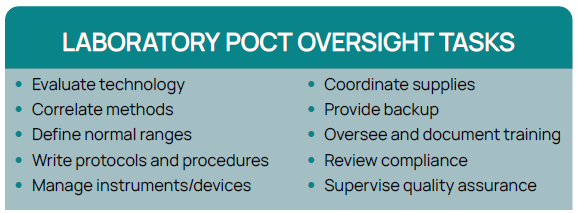 Laboratory professionals play a critical role in overseeing point-of-care testing (POCT) programs, serving as essential knowledge resources and fostering a culture of mutual respect and open communication. This type of oversight enhances the effectiveness of POCT programs and their contribution to patient care.
Laboratory professionals play a critical role in overseeing point-of-care testing (POCT) programs, serving as essential knowledge resources and fostering a culture of mutual respect and open communication. This type of oversight enhances the effectiveness of POCT programs and their contribution to patient care.
Executive Summary
- Laboratory professionals can emphasize the need for clinical staff to understand the reasons behind proper procedures, such as quality control and maintenance, to ensure patient care quality.
- It is crucial in POCT oversight to consider the end user’s workflow when implementing POCT activities to minimize disruption and ensure compliance.
- Laboratory professionals can advocate for a culture focused on continual improvement rather than error-pointing, using tools like Lean Six Sigma’s DMAIC process.
- Laboratory professionals can promote self-management among POCT end users through clear communication and readily available tools such as a POCT website or shared drive that can foster a successful program.
- There is value in a culture of teamwork and collaboration to aid in achieving rapid, accurate results that improve patient care.
- POCT oversight is an opportunity for laboratory professionals to demonstrate their value in the evolving healthcare landscape.
Laboratorians as an Expert Knowledge Resource
Laboratory professionals have the knowledge and laboratory training that means they understand all the intricacies and complexities of patient preparation, specimen collection, and sample handling required to obtain accurate lab results. The laboratory professional’s role in management of a POCT program is as a knowledge resource, transferring this information to the team that performs the POC testing. By setting a culture of mutual respect and encouraging open discussion and communication, you can achieve a more effective POCT program.
Laboratorians overseeing POCT have the training and knowledge to help determine which POC tests are appropriate for the patient population and to assess various methodologies to determine which one is a best fit for end users, providers, and patients. See Figure 1 for POCT laboratory management tasks.

Start with Why
One of the best leadership tools is to create an understanding among clinical staff of why proper steps (e.g., QC, maintenance, etc.) are important, rather than taking the “you have
to do QC or fail inspection” stance. Train end users about test limitations and potential interferences and the importance of evaluating results based on patient presentation.
Always include the why—why these steps are important to patient care.
Set Up POCT Activities with the End User in Mind
When you are implementing a POC test, it is important to consider the end user and how they will fit that POCT into their workflow. As a point-of-care coordinator (POCC), it is wise to streamline QA requirements to achieve goals using minimal resources that have maximum impact on patient quality. Consider the end user’s current workflow and discuss how POCT best fits. Workflow changes may be necessary to optimize POCT implementation but strive for a minimal disruption of routine and determine the new workflow with end user input. QC, proficiency testing, and competency assessments take time away from patient care. Also, different locations, areas, and nursing units may have different workflows that can accommodate regulations in various ways and still be compliant.
Write policies and procedures in a user-friendly, easy-to-understand language, rather than in technical laboratory verbiage. If procedures are put in place that do not allow nursing units to implement POCT in ways that fit their workflow, this can lead to workarounds or noncompliance. Allow individual flexibility in implementation without being too stringent, keeping in mind the goal of error-prevention.
It is also wise to use technology wherever possible to prevent errors by including controls and QA monitors around weak steps that cannot be removed from the testing process (e.g., results cannot be approved without QC, operators not up to date on certification cannot approve results, etc.).
Encourage Continual Quality Improvement
Create a culture that is not about pointing out errors, but about continually striving to improve. One tool available is the Lean Six Sigma five stages of DMAIC (pronounced “duh-may-ik”) for cyclic process improvement.1 See Figure 2. The planning stage involves forming an interdisciplinary POCT team, then cycles through defining, measuring, analyzing, improving, and controlling the processes. Analysis of key performance indicators will lead to development of new indicators to continue making improvements.
DMAIC: Improving Organization Performance
This graphic shows the DMAIC process for ongoing process improvements: define, measure, analyze, improve, and control.

Encourage Self-management
Open and clear communication alongside readily available tools can promote self-management and further improve a POCT program. Having a POCT website or electronic
folder on a shared drive can provide helpful tools for POCT end users. Use the site to house policies and procedures, training and compliance forms, performance improvement goals and progress, committee minutes and agendas, and regulatory updates.1 Give the end users the tools they need to perform their roles, and the laboratory can be available as a consultant. Site self-inspections are recommended as part of a self-sufficient POCT end unit.1 Sites can use the same checklist that the POCC uses for a mock inspection to make
sure their unit is not missing any important steps.
More Strategies to Improve POCT Compliance
Working together as a team to achieve rapid, accurate results that can improve patient care is a worthy goal. Some tactics that can support a teamwork effort include:
- Promoting self-management and recognizing the important role each staff member plays in patient care
- Implementing system changes to address compliance issues, rather than blaming the operator
- Regularly and clearly communicating policies, procedures, program goals, and expectations
- Creating a culture that accepts visibility in the end unit through laboratory visits and interaction1

POCT as an Opportunity to Demonstrate Value
The shift of policies and practices in the direction of value-based and patient-centered healthcare is bringing testing closer to the patient. These trends virtually ensure that the
volume of testing performed outside of the core laboratory will continue to grow. And as healthcare organizations change their models, the role of clinical laboratories—and how
they serve their organizations—will also change. Increasing sophistication and use of POCT is destined to play a major role in this new healthcare paradigm.
The need for experienced, knowledgeable oversight to achieve accurate POCT results so that its rapid TAT can be realized is an opportunity for laboratory professionals to gain visibility and to use their skills and training in a broader healthcare stance. Because of the inherent limitations and trade-off between speed and accuracy/precision, POCT must be diligently monitored so that the speedy results can positively impact patient care. Laboratory expertise is vital to ensure testing is performed where it can have the most positive influence on patient outcomes and that quality results are achieved.
Laboratory professionals must become involved and engaged in the management of POCT to showcase the laboratory’s contribution to the healthcare team and to improve the overall contribution of the laboratory. One way to achieve this is by effectively and collaboratively leading a POCT team.
Orchard® Point-of-Care™
Orchard® Point-of-Care™ offers centralized governance of a comprehensive point-of-care testing program across patient testing locations. The solution includes support for specimen collection, routing, and tracking processes, device management and integration, and a feature-rich competency module.

